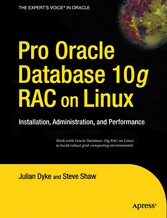Search and Find
Service
More of the content

Pro Oracle Database 10g RAC on Linux - Installation, Administration, and Performance
Contents at a Glance
4
Contents
6
About the Authors
22
About the Technical Reviewers
23
Acknowledgments
24
Introduction
25
Coverage and Audience
26
Standards and Conventions
26
Errata and Additional Material
26
Introduction to RAC
27
What Is Real Application Clusters?
27
Clustered Database Concepts
28
Why Deploy RAC?
33
Alternatives to RAC
41
Differences Between Single- Instance and RAC Databases
42
Differences Between Oracle 9i and Oracle 10g
43
History of Real Application Clusters
45
Summary
46
Introduction to Linux
47
History of Linux
47
Oracle, Open Source, and Linux
51
Summary
55
RAC Concepts
56
Oracle Clusterware
56
Node Applications
58
Database Structure
59
Instances
61
Parameters
62
Background Processes
67
Workload Management
73
Administration
75
Monitoring
76
Tools and Utilities
78
Backup and Recovery
80
Disaster Recovery
80
Summary
82
RAC Design
83
Business Requirements
83
Architecture
86
Storage Requirements
89
Hardware Requirements
94
Application Design
94
Database Design
96
Summary
105
Benchmarking Concepts
106
Load Testing and Benchmarks
106
TPC Benchmarks
109
Summary
121
Hardware
122
Oracle Availability
123
Server Architecture
124
Network and Private Interconnect
140
Summary
147
Storage
148
RAC I/ O Characteristics
148
Storage Fundamentals
153
Storage Protocols for Linux
161
SAN Storage Example
169
NFS and iSCSI Storage Example
181
Summary
193
Oracle Cluster File System ( OCFS)
194
Cluster File Systems and OCFS
194
OCFS Version 1
195
Summary
223
Automatic Storage Management ( ASM)
224
Introducing ASM
224
ASM Installation
225
ASM Instance Configuration
229
ASM Components
235
ASM Administration
243
Monitoring ASIVI
254
Summary
256
Installing Linux
257
Linux Software Selection
257
Hardware Requirements
258
Networlcing Requirements
258
Installing Red Hat Enterprise Linux 4 AS
259
Installing SUSE Linux Enterprise Server
272
Summary
280
Configuring and Verifying Linux
281
Operating System and RPM Package Checks
281
Hostnames and Name Resolution
282
NTP
283
Hangcheck- Timer
285
Kernel Parameters
286
Oracle User Configuration
294
Secure Shell Configuration
301
Shared Storage Configuration
303
Channel Bonding
309
Cluster Verification
312
Summary
321
Installing and Configuring Oracle Software
322
Preparing to Install
322
Oracle Clusterware
324
Oracle Database Software Installation
336
Troubleshooting
341
Configuration Files
344
Deinstallation
345
Summary
346
Creating and Configuring Databases
347
Using DBCA As a GUI Tool
347
Creating a Database Using Scripts
371
Summary
382
Installing and Configuring Enterprise Manager
383
Manageability Infrastructure
384
Database Control
385
Grid Control
386
Summary
404
Linux Administration
405
Run Levels
405
Services
407
Terminal Sessions
408
IVIanual Pages
408
Bash Sliell
409
Packages
413
Kernel Parameters
414
Swap Space and File Systems
415
Booting the System
418
Log Files, Tracing, and Debugging
419
Summary
420
Oracle Clusterware
421
Oracle Clusterware Components
421
Oracle Clusterware Files
422
Oracle Clusterware High Availability Framework
423
Oracle Clusterware Installation and Configuration
424
Administering Oracle Clusterware
428
Administering Voting Disks
442
Oracle Clusterware Logging
443
Summary
443
Application Development
444
RAC- Specific Development Considerations
444
Transparent Application Fallover
449
Fast Application Notification
456
Oracle Clusterware High Availability Framework
465
Summary
482
Using Administrative Tools
483
Using EM
483
Using SRVCTL
493
Using SQL*PIus
505
Summary
510
Workload Management
511
Workload Distribution
511
Database Services
515
Summary
537
Adding and Deleting Nodes and Instances
538
Running GUI Tools
538
Adding a Node
539
Adding an Instance
552
Deleting an Instance
557
Deleting a Node
561
Summary
569
Trace and Diagnostics
570
Trace File Locations
570
ORADEBUG
576
Summary
591
RAC Internals
592
Global Enqueue Services
593
Global Cache Services
598
Instance Recovery
621
Summary
622
Benchmarking Tools: Hammerora and Swingbench
623
Hammerora
623
Swingbench
649
Summary
663
Performance Monitoring
664
Oracle Performance Monitoring
664
Linux Performance Monitoring
687
Summary
696
Backup and Recovery
697
Backup and Recovery Strategy
697
Recovery Manager ( RMAN)
699
RAG Considerations
728
Summary
730
Disaster Recovery
731
Oracle Data Guard
732
Data Protection Modes
733
Redo Transport Services
734
Standby Redo Logs
736
Log Apply Services
737
Role Management
737
RAC and Physical Standby
738
RMAN
739
NOLOGGING Attribute
739
Archive Log Gaps
740
Initialization Parameters
740
Creating a Physical Standby Database
743
Role Management
753
Summary
755
Third- Party Clustering Solutions
756
Clusterware
756
PolyServe Matrix Server
758
Summary
764
Index
765
All prices incl. VAT












